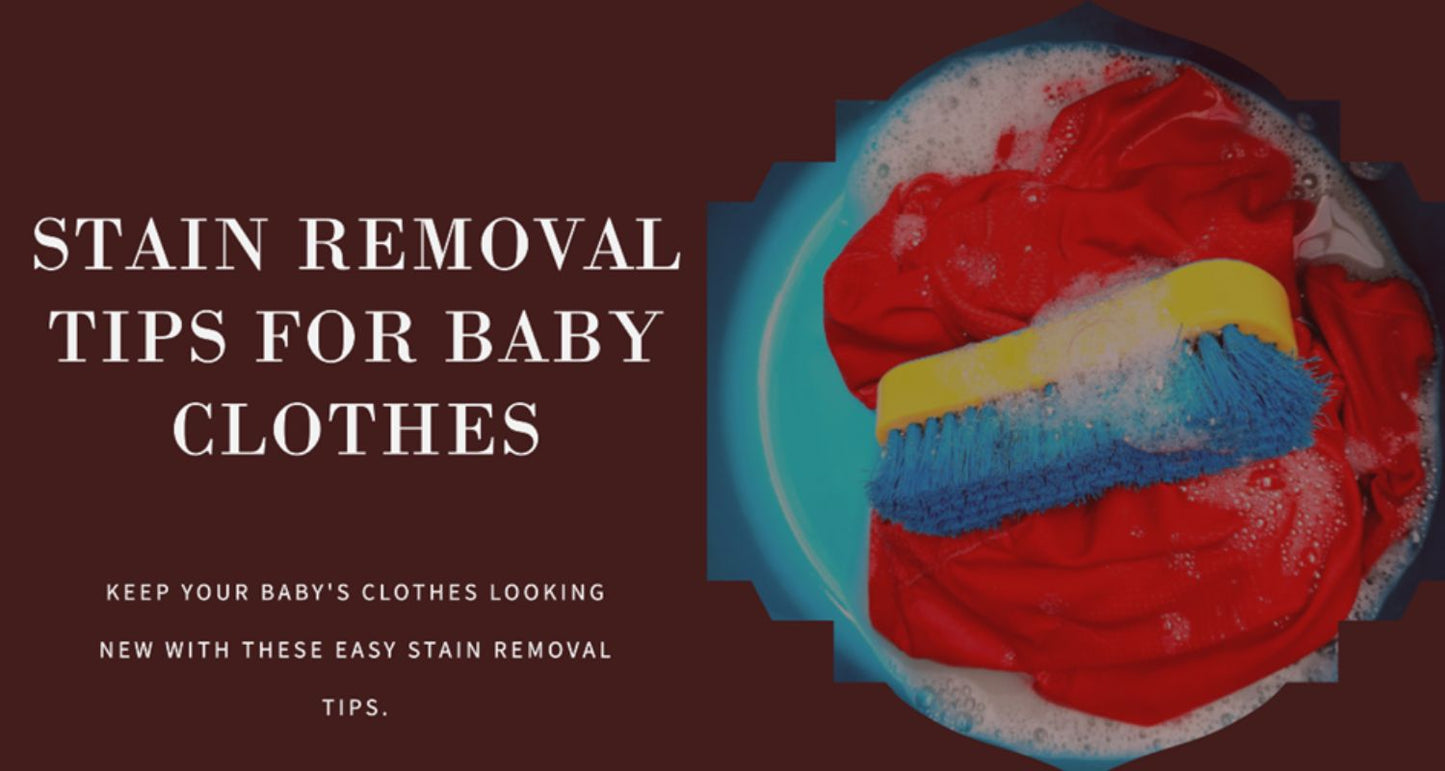
As a parent, I've come to realize that cute baby clothing and stubborn stains go hand in hand. Whether it’s the aftermath of a spinach puree explosion, a surprise diaper leak, or the dreaded milk spit-up, I've faced them all.
And while I've sometimes been tempted to toss a particularly soiled onesie, I've gathered some tried-and-true tricks to tackle those pesky stains. Here's my personal guide on how to remove stains from baby clothes!
My Golden Rules for Stain Fighting:

1. Act Quickly:
Why It Matters: Fresh stains are easier to remove. The longer a stain sits, the more it penetrates the fabric fibers, making it challenging to remove.
What to Do: As soon as you notice a stain, start the removal process, even if it's just a simple rinse with water. This initial step can prevent a stain from setting deep into the fabric.
2. Check Care Labels:
Why It Matters: Baby clothes come in various materials and blends. Some garments might be delicate or have specific care instructions. Following these instructions ensures you won't damage the baby romper during the stain removal process.
What to Do: Before applying any stain removal technique or product, always refer to the garment's care label. This will give you information on washing temperatures, drying recommendations, and what products to avoid.
3. Cold Water Rinse:
Why It Matters: Cold water helps prevent many types of stains from setting. Using hot water initially can cause proteins in certain stains, like milk or blood, to coagulate, making them harder to remove.
What to Do: Hold the stained portion of the garment under cold running water. Allow the water to flow through the back of the stain, which can help push the staining substance out of the fabric. Do this for a few minutes or until you notice the stain lightening.
4. Avoid Heat Until You're Sure:
Why It Matters: Heat can set many types of stains, making them nearly impossible to remove. This includes the heat from a dryer, iron, or even hot water in some cases.
What to Do: After treating and washing the stained clothing, check the stain area before drying. If any part of the stain remains, repeat the stain treatment process. Only once you're confident that the stain is gone should you use heat to dry the garment.
Gather A Few Pre-Wash Supplies
Before diving into the details, ensure you have a few pre-wash supplies on hand. These include:
- A soft-bristled brush or an old toothbrush
- A clean cloth or sponge
- Cold water
- Baby-friendly detergent
Using these supplies, always blot (don't rub) the stain, and rinse with cold water to prevent setting. Apply a small amount of baby-friendly detergent directly to the stain and gently brush with a soft-bristled brush. Rinse again before treating with any specific stain removal methods.
Other Proven Steps And Supplies
1. Distilled White Vinegar
White vinegar is a gentle yet effective stain remover. Mix one part white vinegar with two parts water. Apply the solution to the stain, let it sit for 30 minutes, and rinse. This is particularly effective for protein-based stains like milk.
2. Lemon Juice
Lemon juice, a natural bleaching agent, can help lift stains. Squeeze fresh lemon juice onto the stain, let it sit for 10 minutes, and then rinse with cold water.
3. Baking Soda
For tougher stains, make a paste using baking soda and water. Apply this paste to the stain and let it sit for 30 minutes to an hour before washing.
4. Hydrogen Peroxide
For colored clothing, use a 3% hydrogen peroxide solution. Apply a small amount to the stain, and let it sit for no more than five minutes, then rinse. Always do a patch test first to ensure it doesn't bleach the fabric.
5. Borax Powder
Borax Powder can be used as a pre-soak for stained baby sets. Add a tablespoon of borax powder to a gallon of water, soak the clothes, then wash as usual.
6. Sunlight
The sun is nature’s bleach. After washing the stained clothes, let them dry out in direct sunlight. The sun can help fade stains, especially fruit and vegetable stains.
My Formula for... Well, Formula Stains:

How to Get Formula Stains Out of Baby Clothes
Formula stains can be challenging due to their protein base. Here's a step-by-step guide:
- Cold Water Rinse: Always rinse the stained area with cold water to prevent the protein in the formula from setting.
- Soak: Fill a basin with cold water and a tablespoon of salt. Soak the clothing for a few hours.
- Apply a Stain Remover: Apply baby-friendly detergent or one of the natural stain removers mentioned above to the stain.
- Wash: Wash the clothing in cold water. Before drying, check the stain. If it persists, repeat the process.
How to Remove Poop Stains from Baby Clothes
Poop Stains? Been There, Cleaned That. Here's how to tackle them:
- Scrape Off Excess: Using a spatula or plastic knife, gently scrape off as much poop as you can.
- Cold Water Rinse: Rinse the stain under cold running water to flush out as much of the stain as possible.
- Pre-Treat with Detergent: Apply a liquid detergent directly onto the stain and gently brush using a soft-bristled brush.
- Soak: Fill a basin with warm water and add a half cup of baking soda. Let the garment soak for 2-3 hours.
- Wash: Wash the clothing in warm water with baby-friendly detergent.
- Sun Dry: If possible, let the garment dry out in the sun to help bleach out any remaining discoloration.
Also check out my blog on how to safe your baby from night fever
Conclusion
Stains on baby clothes are inevitable, but with patience and the right methods, they are almost always removable. Always remember to check the care label on any garment before applying any treatment, and when in doubt, do a patch test to ensure there's no damage or discoloration. Keeping baby clothes looking pristine is indeed a challenge, but with these tips and tricks, you're well-equipped to face it.
